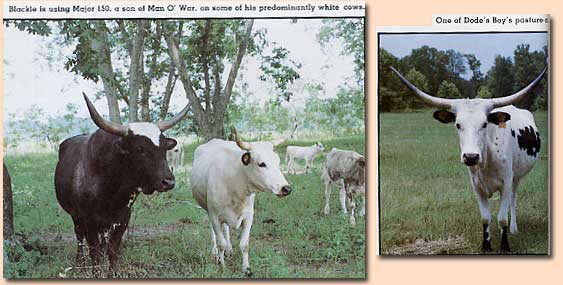 The spacious home of Lorene and F.M. "Blackie" Graves in Dayton, Texas, is an oasis of comfort and good cheer for all the travel-weary visitors who pass their way. They love company, and there's seldom a weekend when the guest wing of the Graves' roomy and beautiful house isn't occupied by friends or family. Lorene has two sons, one living in Port Arthur and the other in Wyoming. Blackie has three daughters, two in Dayton and one in Waco, Texas. A son was killed three years ago in an automobile accident, leaving a wife and young daughter. Altogether there are 13 grandchildren.
The spacious home of Lorene and F.M. "Blackie" Graves in Dayton, Texas, is an oasis of comfort and good cheer for all the travel-weary visitors who pass their way. They love company, and there's seldom a weekend when the guest wing of the Graves' roomy and beautiful house isn't occupied by friends or family. Lorene has two sons, one living in Port Arthur and the other in Wyoming. Blackie has three daughters, two in Dayton and one in Waco, Texas. A son was killed three years ago in an automobile accident, leaving a wife and young daughter. Altogether there are 13 grandchildren.
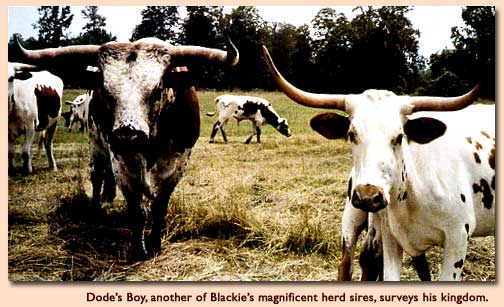 Add to that Lorene's three brothers (one, her twin Lindon Williams, is a Texas Senator) and Blackie's four sisters and two brothers, and you'll quickly see that the combination of children, grandchildren, nieces, nephews, aunts, uncles and other kinfolk that could appear on the Graves' doorstep at any given moment is virtually endless. At special times like Christmas, the entire clan is likely to gather there.
Add to that Lorene's three brothers (one, her twin Lindon Williams, is a Texas Senator) and Blackie's four sisters and two brothers, and you'll quickly see that the combination of children, grandchildren, nieces, nephews, aunts, uncles and other kinfolk that could appear on the Graves' doorstep at any given moment is virtually endless. At special times like Christmas, the entire clan is likely to gather there.
The guest list is further expanded by the Graves' many friends among their fellow Texas Longhorn breeders, who enjoy a standing invitation to drop in whenever they're in the Houston area. Says Lorene: "The greatest people in the world are in the Longhorn business."
"There's people from all walks of life in the Longhorn breed," adds Blackie, "and when they get to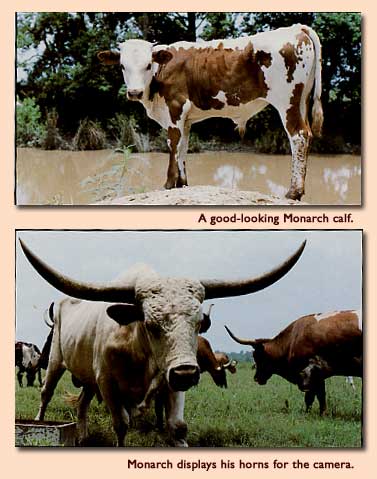 those sales they're all just alike. I think the people in the breed are the greatest people I've ever met. We've just made a lot of friends that we've really enjoyed, people we wouldn't have met otherwise, who are true friends now."
those sales they're all just alike. I think the people in the breed are the greatest people I've ever met. We've just made a lot of friends that we've really enjoyed, people we wouldn't have met otherwise, who are true friends now."
When those friends come to visit, they're treated to a showing of some first-quality Teas Longhorn cattle. On land north and east of Liberty and west of Dayton, Blackie raises some 160 Butler-bred Texas Longhorns, as well as approximately 300 head of Brahman-cross commercial cattle and 4,000 acres of rice and soybeans.
These ranchers/farmers/business people hit the ground running before 6 a.m. and don't slow down until long past dark. Blackie meets with his men by 6:30 every morning to plan the day's work, the early start dictated both by the prodigious amount of work to be done and by the head and humidity of the Gulf Coast climate. A brother, son-in-law and nephew farm with him, taking the major responsibility for the field crops while Blackie sees to the cattle.
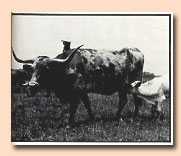 Lorene worked until the spring of this year as manager of a small restaurant in Dayton. She got used to being on the job by 4 a.m., and admits it's awfully hard now for her to stay in bed as late as 6. A woman of many talents, she once owned a beauty and gift shop and has her beauticians license. Her mother is a licensed vocational nurse, and Lorene herself worked four years in a hospital. She's thinking of going back to college and taking nursing. Her energy, like her husband's, seems boundless.
Lorene worked until the spring of this year as manager of a small restaurant in Dayton. She got used to being on the job by 4 a.m., and admits it's awfully hard now for her to stay in bed as late as 6. A woman of many talents, she once owned a beauty and gift shop and has her beauticians license. Her mother is a licensed vocational nurse, and Lorene herself worked four years in a hospital. She's thinking of going back to college and taking nursing. Her energy, like her husband's, seems boundless.
Longhorns Since 1962
Blackie got into Longhorn cattle as a hobby in 1962. "I went down to Mr. (Milby) Butler's to take some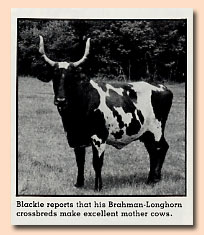 mares to their stallion, and that was the first time I'd seen any Longhorns," he recalls. "I wanted some as a hobby to start with, and I got a bull first; then Mr. Partlow over here, he gave me the first cows I had. Later on, Mr. Butler started selling me some cows. The reason I have the Butler cows is strictly all luck. That's the only place I knew to get any."
mares to their stallion, and that was the first time I'd seen any Longhorns," he recalls. "I wanted some as a hobby to start with, and I got a bull first; then Mr. Partlow over here, he gave me the first cows I had. Later on, Mr. Butler started selling me some cows. The reason I have the Butler cows is strictly all luck. That's the only place I knew to get any."
For years, the Graves Longhorns grazed contentedly across the coastal prairies, virtually unknown to but family members and neighbors, doing what they do best: producing calves. About 1971, Blackie decided he had to do something with the rapidly growing herd, so he crossed a few of the mature cows with a Brahman bull to see what would happen.
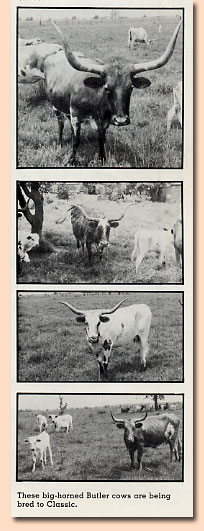 "At the time, Longhorns weren't worth much and I was getting too many of 'em," he explained. "That's the reason I crossed them. I started out just wanting 15 or 20 as a hobby, to look at and raise some steers, but then I found it a pretty good business."
"At the time, Longhorns weren't worth much and I was getting too many of 'em," he explained. "That's the reason I crossed them. I started out just wanting 15 or 20 as a hobby, to look at and raise some steers, but then I found it a pretty good business."
Blackie reports excellent results with the Brahman x Longhorn crossbreds. "They've made some awfully good cows, with that cross. And I think everybody else who's crossed Longhorns with Herefords or whatever else has had good luck with them."
The Brahman x Longhorn cows are now about 11 years old. Blackie breeds them back to a 3/4 Hereford, 1/4 Brahman commercial bull. He gets a calf out of every cow every year, and says they do great. The prices he gets for these calves are as good as for any commercial crossbreds, and since the half-Longhorn cows are so prolific and calve every year, he feels they probably make him more money.
But back to the purebred Longhorns. Blackie continued to raise his Butler cattle in relative obscurity until 1977. Then the great bulls Classic and Monarch came into his life, and things have never been the same since.
"The best thing that's ever happened to him was that he got Classic and Monarch," says Lorene, and Blackie agrees.
"That helped me more than anything I ever did," he said. "But it was just luck. It wasn't planned, or anything I did that was smart. I was just lucky to be at the right place at the right time when Pauline Russell sold them."
Ms. Russell of Liberty, Texas, raised Classic, and when the bull was four years old she put him, Monarch (then a 2-year-old), Lady Butler, Reveille, and some other Butler Longhorns in a commercial sale. Blackie purchased Classic and Monarch and brought them home to Dayton.
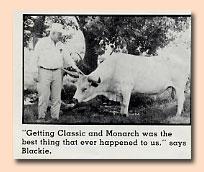 Classic had 59-inch horns at age four. Eventually they grew into 61 inches, though Blackie figures they are somewhat shorter than that now, as the bull is 10 years old and probably has worn his horns down a little.
Classic had 59-inch horns at age four. Eventually they grew into 61 inches, though Blackie figures they are somewhat shorter than that now, as the bull is 10 years old and probably has worn his horns down a little.
Blackie said he never dreamed Classic would become a celebrity, a legend in his own time among Longhorn enthusiasts. He didn't fully realize what a find he'd made, in fact, until a fellow Longhorn breeder, who shall here remain nameless at Blackie's request, got word of the bull's existence.
"This fellow called me," Blackie relates, "and we were talking...I don't know how it came up, but I told him I didn't really think much about horns, told him I'd bought a little ol' bull down here that had 59-inch horns.
" 'Naw, you mean 49 inches," he said.
"I said, 'no, I don't. I mean 59.' And in about a week, he was down here, to see that bull."
Classic put Dayton on the map among Longhorn breeders, and pulled Blackie's Longhorns out of peaceful seclusion into the limelight.
"We never did any advertising or anything until we got him," Blackie explained, "and there wasn't hardly anybody who even knew we had Longhorns down here to amount to anything."
These days, the bull is at home near Dayton, though until just recently he shuttled back and forth between the Graves' coastal pastures and the McCombs ranches of central Texas, where Red McCombs of San Antonio has used him for natural service. Red owns half the semen interest in Classic.
Blackie has as much respect for Monarch as for the record-setting Classic. "I think Monarch probably breeds just as good as Classic, but I haven't done as much advertising on him, and haven't bred him as much, and his horns aren't quite as long, but you know I showed you some awfully pretty calves of his." (Indeed, he did.)
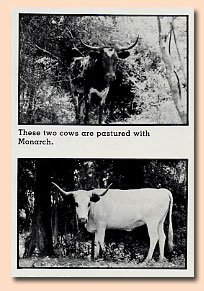
"I had Monarch in a little pasture down the road from here, and I couldn't put but about 15 cows with him," Blackie said. "I had the best cows, naturally, with Classic, and I didn't raise many Monarch calves till last year. I've got probably 30 calves out of him this year.
"He's just as good as Classic, I think. He's out of Bevo and Lady Butler, which was a daughter of Bevo and Beauty. In other words, he was out of Classic's full sister and his daddy, so he's got a little bit more of a concentration of that blood in him than Classic has."
"I've had real good luck putting Classic on Man O'War cows, so I'm putting a Man O'War bull back on the Classic cows," he said. "But really I haven't had much of a breeding program, most of mine has just been luck, to get what I've got. I have tried to keep my cattle mostly Butler. My cattle are mostly a mixture of Butler and WR." Last year, Blackie bought 34 Wildlife-bred cows. "And I've got one Texas Ranger heifer," he added.
Buying and Selling
Blackie and Alan Sparger have now had two annual Graves-Sparger "Southern Heritage" sales, and plan the 1st Annual Graves-Sparger Consignment Sale for October 15 in D'Hanis, Texas.
"We've been selling our cattle mostly in sales," Blackie said. "And if we're going to be supplying those sales, then I haven't been selling any females at private treaty. We might one of these days if we raise enough."
Blackie buys cattle both at sales and privately. "I've bought some from individuals and some through sales," he said. "If you're going to sell in sales, and expect people to buy your cattle, you've got to buy a few in sales - reciprocate."
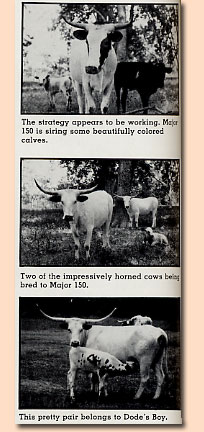 The commercial market for his Longhorn bull calves has been steady in the past, but Blackie reports a recent slump. "The market has been though this year on commercial bulls," he said. "There's getting to be enough breeders up north, where those big ranches are up in Montana and Idaho and all up there. I was selling bulls to them. But now they can get their bulls in Colorado. For them to come down here, it's just that much farther, another 1,100 to 1,200 miles on down here. Since there's enough breeders up there closer to them, naturally they're going to buy bulls up there."
The commercial market for his Longhorn bull calves has been steady in the past, but Blackie reports a recent slump. "The market has been though this year on commercial bulls," he said. "There's getting to be enough breeders up north, where those big ranches are up in Montana and Idaho and all up there. I was selling bulls to them. But now they can get their bulls in Colorado. For them to come down here, it's just that much farther, another 1,100 to 1,200 miles on down here. Since there's enough breeders up there closer to them, naturally they're going to buy bulls up there."
The Houston-area market has slipped, too. "There used to be a lot of cattle in this country, but there's not anymore," Blackie explained. "It used to be a rice and cattle rotation, now it's rice and soybeans. And when these farmers got into soybeans. And when these farmers got into soybeans, they tore their fences down. Everything was farmed.
"Now they'd probably like to be back in cattle, but it costs so much money to put their fences back up, and farming has been so hard, that they just don't have the money to put their fences back and get back in cattle.
"And really, I don't know that commercial cattle are making much money anyway, the price of them right now. All the cow-calf operators are just having a hard time making any money. It's costing so much now to raise 'em. When you've got a $5- or $6- or $700 cow running on $1,500-acre land, and it takes five acres to a cow in this country, you're looking at an investment. You can put that in the bank and make a whole lot more money, with no risk at all."
Two Ways to Go
How about putting that money in Texas Longhorns instead? Asked for his advice to new or prospective breeders of Texas Longhorn cattle, Blackie replied that he would have to know the newcomers' long-range plans before he could advise them.
"It looks to me like there's getting to be enough cows that there's probably two ways you could go," he said. "You could buy the cheaper cows and raise roping steers or commercial bulls for those big ranches, or you could buy the high-priced cows and go with the people who are trying to buy the longest-horned, prettiest cows.
"It looks to me like the thing is pretty well getting to be two classes of cattle. It's growing in that direction now. The good cows are still bringing a whole lot of money, and the cows that are not quite so good are getting pretty cheap, compared to what they were a year or two years ago. People are getting more discriminating in the cattle they buy, where used to, when there was a shortage of them, everything sold good.
"So there's kind of two ways to go, as I see it.What I'd advise a new breeder would depend on what they were wanting to do. If they were going to stay with it and try to raise the best and had a lot of money to invest, then I think they should buy the best cows. If they were going to be a small breeder, maybe they'd want to start with just a few real good cows.
"Or if they were going to try to raise for the commercial bull or roping steer markets, then a lower-priced cow with not quite as long horns or as pretty a color will raise just as good a commercial bull as one of the real high-priced ones," Blackie noted.
For himself, the quest to raise longer horns and prettier colors holds the most attraction. But conformation is an important concern, and Blackie doesn't hesitate to cull cattle that he feels are not up to the standards of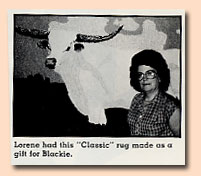 the Texas Longhorn breed.
the Texas Longhorn breed.
"Naturally, anybody is going to have some cull cattle, and I do cull them," he said. "You sell part of them that you don't like as well, and I have sent some to slaughter before, some with bad defects, maybe real swaybacked. I've had one or two that just weren't up to par, and I've culled them."
"But that's about all. Not too many - I haven't had many cattle that I didn't like pretty well," he added.
"I do think we're going to have to start paying more attention to conformation and pedigrees in the cattle than we have in the past," Blackie continued. "There are more people getting aware of conformation. And there's no reason you can't have pedigrees, horns and conformation together."
"An important aspect of the conformation issue is the confusion that arises over exactly what conformation is. A Texas Longhorn breeder who speaks of conformation usually refers to typical Texas Longhorn characteristics, the physical traits of the breed that make it unique. A commercial cattleman, however, often thinks "beefy" when he uses the term. More education is needed to show commercial operators that beefy is not always best.
"A lot of commercial breeders want a small calf, but they can't get away from thinking about a beefy bull," Blackie said. "Until you explain to them that they don't want a real beefy bull if they're going to get a small calf, it's awful hard for a commercial cow-calf operator to buy these little stringy-looking bulls. But really, when they're going to put them on their first calf heifers, that's best. And calves out of Longhorn bulls will grow out just as well as from beefier-type bulls."
Blackie generally approves of the advertising done both by the TLBAA and individual Texas Longhorn breeders for its educational value in converting commercial cattlemen. "They're doing more and more of it and I think it's gotten to be more effective," he said.
But there's really no substitute for firsthand experience.
"A lot of these breeders, I've had 'em tell me their neighbors wouldn't be convinced and they'd finally talk them into using a bull on loan the first year so they could see the difference," Blackie commented. "When they didn't have to pull all those calves, then they'd certainly buy a bull the next year."
Many of Blackie's neighbors were openly skeptical when the Graves' brought their first Longhorns home to Dayton 21 years ago. "When I first got into those things, everybody made fun of me for having 'em," Blackie recalled, laughing with his customary good humor as he remembered introducing "them little ol' narrow things" to Liberty County. And even though the Graves' are still about the only farmers around Dayton to have Longhorn cattle, disbelief has turned to genuine appreciation among friends and neighbors, many of whom now pitch in to help at cattle-working time.
"There's enough volunteers," Blackie said. "Some of these local boys, they like to go to sales with us, and they like to come out just to be around these Longhorns. And those nephews of mine, I raised them and they know how to work cattle. I can pull them off of something else, if I need them to help me."
What'll It Be?
The anticipation that surrounds each new calf crop is a facet of the Longhorn business that Lorene and Blackie particularly enjoy.
"The biggest pleasure is wondering how long their horns are going to be and what color that calf is going to be," Blackie said. "I used to raise Appaloosa horses, and that was the same way. You always wondered if you were going to get a colored colt, if he'd have a blanket. You'd have to wait 11 months to find out. Raising these Longhorn cattle is the same way."
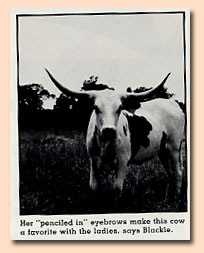 Like many of their fellow Texas Longhorn breeders, Blackie and Lorene have watched their hobby grow into a profitable business.
Like many of their fellow Texas Longhorn breeders, Blackie and Lorene have watched their hobby grow into a profitable business.
"For years, you know, I just had 'em out there and kind of kept 'em separate, and we enjoyed having them," Blackie said. "I raised some steers. It was something different, and I enjoyed that.
"It was a hobby until it got to where it would make money, then naturally I was doing it for the money," he continued. "As the Y.O. puts in their ads, "We breed Texas Longhorns because they make us money," For the last good many years, that's kind of the reason I've been raising them. Farm prices being like they've been, Longhorns sure have supplemented our income. It's been real good for us. We were lucky to have 'em, to be in the Longhorn business."
Judging by the quality of the cattle they raise and the value they place on their friendships among Longhorn breeders, Lorene and Blackie Graves have given back to the business as much as they've gotten from it, or more. Texas Longhorn breeders are equally lucky to have Blackie and Lorene solidly among their ranks.